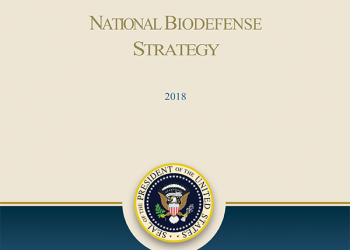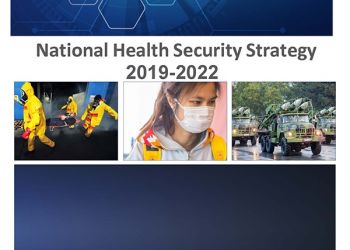The Office of the Assistant Secretary for Preparedness and Response (ASPR) coordinates the development, implementation, and evaluation of the National Health Security Strategy (NHSS) and National Biodefense Strategy (NBS) with the objective to address 21st century health security threats and advance the U.S. health security enterprise through prevention, preparedness, response, recovery, and mitigation efforts.1,2,3 Both strategies play an integral role in improving preparedness to disasters and public health emergencies and require a collective effort across the federal government, state, local, tribal, and territorial (SLTT) authorities, private sector, nongovernmental, academic, and international stakeholders.2,3
The Coronavirus Disease 2019 (COVID-19) pandemic has highlighted health security challenges that need to be addressed in future national strategies, and feedback from stakeholders such as local health departments (LHDs) is critical to the development of these strategies. Sara Garrington, the Emergency Preparedness and Response Manager from the Tri-County Health Department serving Adams, Arapahoe, and Douglas Counties in Colorado, participated in the 2021 NACCHO Preparedness Summit on-demand session titled National Health Security and National Biodefense Strategy: Adapting to Evolving Health Security Threats When Crisis is Commonplace. Garrington shared her thoughts on top health security priorities moving forward given the COVID-19 environment and evolving threat landscape.
Per Garrington, “although it is challenging to pinpoint priorities with various future unknowns, it is important for the Tri-County Health Department to focus on being capability-based versus threat-based. All threats are interconnected (e.g., climate change, increase in infectious disease outbreaks, etc.) and how we respond to and mitigate the consequences of these incidents through our response infrastructure is directly tied to our capabilities. Because the future is unknown, there is an ongoing need to continue to build capacity and capability depth rather than plan for the specifics of a particular threat.”
Along with LHD coordination, partnerships with nonprofit organizations such as the National Association of County and City Health Officials (NACCHO) are critical for sharing the health security message within the public health space. Adriane Casalotti, NACCHO’s Chief of Government and Public Affairs, weighed in on the importance of partnerships while addressing health security priorities.
“We’ve seen during the COVID-19 pandemic that the three levels of governmental public health – federal, state, and local – need to work together and be involved in the overall strategy to be successful. Under the umbrella of public health, each level has a role to play. As we move toward the next strategy, we must highlight the unique, necessary pieces at the local and community levels that ensure the strategy not only focuses on where we’re going but how we’re going to get there. That’s where the boots on the ground at local health departments and in communities make a difference. The pandemic has highlighted numerous ways that local health departments are a key part of our nation’s health security infrastructure, but it has also provided lessons on what more is needed. LHDs are the chief community health strategists in their areas, and they must be empowered to cultivate relationships with community leaders (e.g., healthcare, transportation, housing, education, etc.) before crisis hits to ensure operational plans exist for an all-sector response.”
Casalotti highlighted several recommendations to improve coordination and communication with local and community stakeholders, including:
Ensuring that LHD expertise informs national and state planning.
Paying attention to the delivery of critical medical innovations (sometimes described as the last inch) and the role public health has to play in driving demand and community acceptance of innovations like vaccines or other medical countermeasures.
Providing sustained, predictable investments in our nation’s public health infrastructure, including our professional workforce, volunteers (like the Medical Reserve Corps), and data systems. She noted that it is essential to recruit and retain top talent to staff our health departments with the skill sets necessary to conduct the foundational public health capabilities, as well as build and update data and data systems to assist real-time decisions with an eye towards equity and focus on cyber security.
Casalotti concluded by stating, “COVID-19 has shown that wherever your community is – no matter how big it is, no matter where it is geographically – we are all at risk. Investing is not only important at the federal, state, or community level, but in all communities because health security threats don’t discriminate. We are only as strong as the public health system in the community next to us and the community next to them. We cannot leave any corners of the nation behind.”
This article is the fourth in a series of articles aimed at providing education regarding key national health security concerns such as new and evolving 21st century health threats, federal government mitigation strategies used to support SLTT authorities, and future health security priorities. Please continue to follow this topic series on NACCHO’s Preparedness Brief as we further cover the following features of national health security concerns and corresponding mitigation strategies:
- Health Security Issues of Concern from the Federal Government Perspective
- Looking to the Future: Informing Development of the 2023-2026 NHSS
1. U.S. Department of Health & Human Services, Office of the Assistant Secretary for Preparedness and Response. HHS Office of the Assistant Secretary for Preparedness and Response. Retrieved on August 20, 2021 from: https://www.phe.gov/about/aspr/Pages/default.aspx
2. U.S. Department of Health & Human Services, Office of the Assistant Secretary for Preparedness and Response. National Health Security Strategy (NHSS). Retrieved on August 20, 2021 from: https://www.phe.gov/Preparedness/planning/authority/nhss/Pages/default.aspx
3. U.S. Department of Health & Human Services, Office of the Assistant Secretary for Preparedness and Response. National Biodefense Strategy. Retrieved on August 20, 2021 from: https://www.phe.gov/Preparedness/biodefense-strategy/Pages/default.aspx



